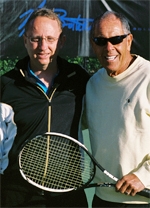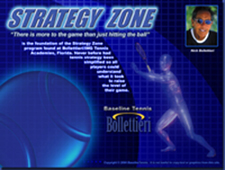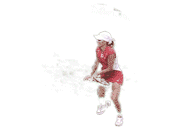The Strategy Zone:
The Serve and Volley Finish
Nick Bollettierri with Lance Luciani
Because of the blistering returns in the modern game, pure serve and volley players are harder and harder to find. The power and speed of the returns can intimidate the server from moving forward to the net.
But there is no doubt that adding serve and volley tactics can result in winning more matches, especially against certain opponent's. It's not easy, but it certainly has a place in today's game.
This is why it's a regular part of the work we do at the Academy. In this final article in the Strategy Zone series for Tennisplayer.net, we'll outline exactly what we teach and how to incorporate it into your own game. (Click Here to see the whole series.)
Serve and volley rarely becomes a player's predominant strategic style. But for most players, and this includes all levels, it can add an element of surprise that can yield the few extra points that make the difference in close matches.
At critical times playing serve and volley can create mental pressure on the opponent, challenging him to hit a passing shot in a tight situation. The result is often an error even at the pro level.
We can break the development of the serve and volley finish down into 4 components. Understanding and mastering them is the prerequisite to adding this dimension to your game.
Serve Placement
For a serve and volley sequence to have a chance to succeed, the server must gain control at the beginning of the point through the placement of the serve. This means first of all the ability to hit accurately wide and down the T in both courts. It also means the ability to hit serves at the body on both the forehand and backhand sides.
The 4 components are: |
||
| Serve Placement | Timing of Footwork | |
| Anticipation of the Return | Mastery of Target Areas | |
One placement or another may be particularly effective against a certain opponent and can be used repeatedly. At higher levels, a mixture of deliveries is usually required to keep opponents off balance and uncertain.
After taking control with the serve placement, the next step is to hit a balanced first volley. This allows you to maintain control of the point, hurt the opponent, and/or finish the point with a winning volley.
Part of becoming an effective serve and volleyer is understanding how to pair your serve locations with your subsequent volley placements and combinations. This is way the Strategy Zone system features drills for multiple combinations of serves and volley placements. (Click Here.)
Certain volley placements will naturally follow from the placements of the serve. A really effective wide serve in the deuce court will often yield volleys winners into the open court. But with some serve locations players will need to hit a second or even third volley to finish.
Timing of Footwork
Controlled balance on the first volley is what allows the player to accurately direct the shot to the target area. To do this the player must find the rhythm between the numbers of steps he moves forward and the split step. Timing the footwork allows the player to establish a solid foundation and then react effectively and move forward to the first volley.
In the modern game, it's not about how far the players get in toward the net, it's about getting balanced so they have a chance to successfully volley those rocketing, dipping returns. If you watch the best players in the world, after landing on the serve, they take only one or two steps before the split in most sequences.
This means that the split step is usually about half way between the service line and the baseline. It's a very difficult position from which to achieve volley control and explains a lot about the reduced serve and volley play in pro tennis.
To time the split step and get balanced, the top players start the split as the opponents begin the forward swing. They are usually in the air by the time the ball is actually struck or shortly thereafter.
But the goal in making the split step is not to reach some specific spot. It's about timing. The point is to time the split to be on balance and able to react and move to the opponent's ball. Players at lower levels may actually be able to close further than the top players depending on the pace of the exchanges.
Anticipation
The successful server and volley player must develop the ability to anticipate the return. This means anticipating the ball speed, placement, height, and type and amount of spin. Good anticipation results from the ability to read the cues from the returner's body position and swing, but also from the ability to read the shot as it leaves the racket.
In addition, certain serve placements will tend to produce certain returns, and this is particularly true when the player studies and understands his opponents and their strengths and weaknesses and typical return patterns.
Anticipation is developed over time as a result of playing the various patterns over and over. Eventually you find you have almost a sixth sense of what the opponent is going to do. But remember, to develop this skill and the ability to use it effectively, you have to commit to actually trying it and doing so repeatedly both in practices and in matches, even if initially it doesn't yield the optimum result.
A basic principle here to adjust the path of your approach to the location of the serve, and therefore the place from which your opponent makes his return. For example, if you serve wide in the deuce court, you will approach on a diagonal somewhat more from your right to your left to stay in the middle of your opponent's angles. If you serve down the T or directly at the body, your approach is more directly forward, again following the line of your serve placement.
Target Areas
Knowing where to go when with which volleys is critical in effective serve and volley play. In the Strategy Zone system we describe the 3 runways all players must master to be able to exploit all their opportunities at the net. The first runway is directly back at or behind the opponent. The second runway is down the middle, and the third is into the open court.
When should you volley directly into the open court? When should you volley back to or behind your opponent? When is the low down the center volley the best play? What about short angles and drop volleys?
The principle for finishing at the net is the same as in the other sequences we've looked at. You should try to finish at the net when we can hit successfully into a large target area and either hit a clean winner or force the opponent further at of position and/or into an error.
This is why it's not necessarily right to hit the ball into the open court, particularly on the first volley. Hitting into the open court may seem like the obvious play. It can result in winners If your opponent is far enough out of position and can't catch up to the ball, or if you can sharpen the angle or successfully drop the ball.
But what if your opponent covers the shot? Now your court can be wide open down the line for his passing shot. So if cannot truly hurt your opponent or finish the point, it's better to go back at your opponent or behind him, because this reduces the angles for a possible pass. It also allows you the critical time you need to close further.
The same is true for going down the middle of the court. In all these cases, you are treating the first volley almost as an approach shot to set up a possible volley winner on the next ball.
To make these decisions you must first have the ability to execute all the options with confidence. This is why the Strategy Zone we give players a range of progressive drills to develop all these options.
Playing serve and volley requires mastery of the same elements as the various groundstroke and approach finishes in our system: the ability to control the serve to all areas of the box, the ability to use to get control of the point: the ability to get or stay ahead with the first volley when necessary, and the ability to finish when you can hit a relatively high percentage volley into a relatively large target area.
The difficulty of combining and executing all these elements requires that they be practiced in progressive controlled drills. But few players have that discipline and determination. Do you?
Is your serve accurate enough to create attacking patterns? Can you time your split step and hit balanced first volleys? Can you hit volleys off either side to all three run ways? Do you know when to finish and can you hit the angles and placements to do so?
This is just one example of the great challenges and potential satisfactions in the game of tennis. Here's wishing you a lifetime of success in developing all the strategic aspects of your game and becoming as complete and successful player as possible.
We hope you've enjoyed and learned from our presentation of the Strategy Zone concepts and the three point progression of control, hurt, and finish. Click Here to see a list of the whole series. See everyone later on Tennisplayer!






